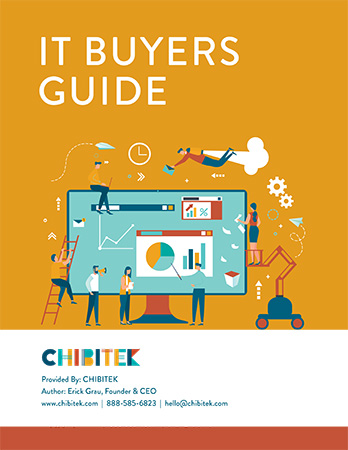
"You will never see one dollar of this money", Ransom (1996), when Mel Gibson’s character, Tom Mullen, turns the tables on the kidnappers by going live on television and placing a bounty instead of paying the ransom. Credit: Touchstone Pictures)
What the PowerSchool Breach Teaches Every Business—Big or Small
By Erick Grau | Chibitek
In late 2023, one of the country’s largest educational technology providers, PowerSchool, fell victim to a coordinated ransomware attack. The breach compromised personal student data across hundreds of school districts. A 19-year-old hacker demanded $2.85 million in Bitcoin. PowerSchool paid the ransom.
But the story didn’t end there.
Even after paying, individual school districts were still extorted—proving once again that you cannot negotiate your way out of poor cybersecurity. You can’t pay for trust. And you certainly can’t buy your way back into safety after a breach. What’s stolen is stolen.
This isn’t a one-off incident. It’s a wake-up call.
The Illusion of “Too Small to Target”
At Chibitek, we regularly hear business owners say, “Why would anyone target us? We’re just a small firm.” That’s the exact kind of thinking attackers exploit.
Here’s the uncomfortable truth: smaller organizations are low-hanging fruit.
According to a 2024 Hornetsecurity survey, nearly 56% of ransomware attacks targeted businesses with 1–50 employees. The same year, the FBI reported that U.S. ransomware victims collectively lost $16.6 billion, up from $11 billion in 2023—a 33% year-over-year increase (TechRadar).
Why the spike? Because small and mid-sized businesses often:
-
Underfund their cybersecurity
-
Lack dedicated IT security staff
-
Misjudge the value of their data
-
Fail to implement basic protections like multi-factor authentication
They assume a hacker would prefer to go after the “big fish”—meanwhile, attackers are casting nets across oceans of smaller, less-defended targets.
Ransom Paid ≠ Data Secured
The PowerSchool case exposed a second myth: that paying the ransom ends the attack. It doesn’t. In fact, PowerSchool confirmed that even after payment, the criminal continued extorting individual school districts whose data was already in the wild.
This aligns with broader findings from IBM’s 2024 Cost of a Data Breach Report: the average cost of a breach is now $4.9 million, up 10% from the year before. That figure includes incident response, legal fees, system restoration, loss of business, and yes—ransom payments.
But what it doesn’t cover is trust. Or reputation. Or the haunting reality that stolen data often resurfaces months or years later on dark web marketplaces.
Prevention Is the Bargain. Recovery Is the Blow.
Many small business owners hesitate to invest in strong cybersecurity because it feels “expensive.” But not investing is far more costly.
A 2023 Cybersecurity Ventures study found that 60% of small companies go out of business within six months of a cyberattack. Let that sink in. For most, there is no “bounce back.” There’s only impact and aftermath.
So, if ransom doesn’t work, what does?
A Better Path: Infrastructure + Partnership
The answer isn’t just better software. It’s strategic alignment with the right IT partner—one who understands the nuances of your environment, anticipates threats before they materialize, and helps design your infrastructure with security at its core.
This means:
-
A layered approach to endpoint protection, backups, and user access controls
-
24/7 system monitoring and rapid response procedures
-
Educating your team to recognize phishing and social engineering attempts
-
Regular patching, asset audits, and privilege reviews
-
And—just as important—a partner who knows your business
You don’t need a 100-person IT department to get Fortune 500-level protection. But you do need a proactive, embedded team who shows up before the crisis—not after.
Chibitek: Built for the Underdog
We started Chibitek with a single belief: small companies shouldn’t have to pay more for security after the fact when they could pay less to prevent it from happening in the first place.
Our clients aren’t giant corporations with unlimited budgets. They’re PR firms, dental practices, healthcare groups, and nonprofits. They run lean. They move fast. And they can’t afford to go dark for a week because someone clicked the wrong link.
That’s why our model includes:
-
Enterprise-grade security tools at predictable pricing
-
Round-the-clock monitoring and support
-
Fully managed backups, EDR, phishing defense, and real-time alerting
-
Systems that scale with you—without sacrificing compliance or speed
You may not think you’re a target. But in the eyes of a hacker, you’re a storefront with a door wide open. And once they’re in, paying them won’t lock that door again.
Final Thought: Don’t React. Restructure.
The worst time to meet your cybersecurity partner is during an emergency. The right time is now—before you’re forced to write a check to a criminal.
At Chibitek, we don’t believe in fear-mongering. We believe in facts, frameworks, and futureproofing. You don’t need panic. You need a plan.
And we’re ready to help you build it.
🚀 Ready to Work with Award-Winning IT Experts?
Whether you’re scaling your creative agency or leading a fast-moving startup, we’ve got the tools, team, and mindset to help you grow.
Start with a FREE AI & Network Assessment to identify vulnerabilities and safeguard your data against cyberthreats.
Click here to schedule your FREE AI & Network Assessment today!
We Make IT Effortless, So You Can Disrupt, Create, and Grow












